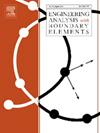反泊松问题的深度学习-复变量无网格方法
IF 4.1
2区 工程技术
Q1 ENGINEERING, MULTIDISCIPLINARY
Engineering Analysis with Boundary Elements
Pub Date : 2025-10-11
DOI:10.1016/j.enganabound.2025.106495
引用次数: 0
摘要
本文提出了一种深度学习-复杂变量无网格方法(DL-CVMM)框架,该框架将深度神经网络(dnn)与改进的无复杂变量伽辽金(ICVEFG)方法相结合,用于求解逆泊松问题。该框架以二维坐标作为输入,并通过dnn中的前向传播预测源项。然后将这些预测的源项合并到ICVEFG离散方案中以重建物理场。反问题是通过最小化重构值与观测值之间的问题域内的经验风险函数来实现的优化问题。该框架利用dnn进行源项预测,利用其泛化和学习能力,同时采用ICVEFG方法进行有效的物理场重建。与无单元伽辽金(EFG)方法相比,ICVEFG的一个关键优点是减少了未知系数的数量,降低了形状函数计算中的矩阵阶数。在三个二维泊松反问题基准上的严格验证表明,DL-CVMM框架具有良好的收敛性和计算精度。本文章由计算机程序翻译,如有差异,请以英文原文为准。
Deep learning-complex variable meshless method for inverse Poisson problems
This study proposes a deep learning-complex variable meshless method (DL-CVMM) framework that integrates deep neural networks (DNNs) with an improved complex variable element-free Galerkin (ICVEFG) method for solving inverse Poisson problem. The framework takes 2D coordinates as input and predicts source terms via forward propagation in DNNs. These predicted source terms are then incorporated into the ICVEFG discretization scheme to reconstruct the physical field. The inverse problem is formulated as an optimization problem by minimizing the empirical risk function in the problem domain between the reconstructed and observed values. This framework leverages DNNs for source term prediction, harnessing their generalization and learning capabilities, while employing the ICVEFG method for efficient physical field reconstruction. A key advantage of ICVEFG compared to the element-free Galerkin (EFG) method is its reduction in the number of unknown coefficients, reducing the matrix order in the shape function computations. Rigorous validations on three 2D Poisson inverse problem benchmarks demonstrate that the DL-CVMM framework achieves good convergence and computational accuracy.
求助全文
通过发布文献求助,成功后即可免费获取论文全文。
去求助
来源期刊

Engineering Analysis with Boundary Elements
工程技术-工程:综合
CiteScore
5.50
自引率
18.20%
发文量
368
审稿时长
56 days
期刊介绍:
This journal is specifically dedicated to the dissemination of the latest developments of new engineering analysis techniques using boundary elements and other mesh reduction methods.
Boundary element (BEM) and mesh reduction methods (MRM) are very active areas of research with the techniques being applied to solve increasingly complex problems. The journal stresses the importance of these applications as well as their computational aspects, reliability and robustness.
The main criteria for publication will be the originality of the work being reported, its potential usefulness and applications of the methods to new fields.
In addition to regular issues, the journal publishes a series of special issues dealing with specific areas of current research.
The journal has, for many years, provided a channel of communication between academics and industrial researchers working in mesh reduction methods
Fields Covered:
• Boundary Element Methods (BEM)
• Mesh Reduction Methods (MRM)
• Meshless Methods
• Integral Equations
• Applications of BEM/MRM in Engineering
• Numerical Methods related to BEM/MRM
• Computational Techniques
• Combination of Different Methods
• Advanced Formulations.
 求助内容:
求助内容: 应助结果提醒方式:
应助结果提醒方式:


